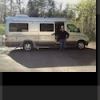
Indeed, for Jennifer and I, that is our favorite place to be.
But that’s not the only place to be.
As I write this, we just spend a night boondocking in the parking lot of a hotel near Memphis, Tenn.
It was a quiet, peaceful night. We parked in an out-of -the-way spot in our Roadtrek Etrek. It was typically hot, as it always is in late July in the south. The outside temperature barely dipped below 80. We fired up the Etrek air conditioner and let it run a couple of hours. It got so cold we turned it off a little after midnight. Then we opened the widows, opened the roof vent and turned on the Fantastic Fan. We also used a small oscillating fan we plugged into an AC outlet.
We slept like babies all night.
Let me say right now that such boondocking is controversial.S ome RVers do this regularly, albeit clandestinely. They just pull in, and go to sleep. That’s the beauty of a Class B. It is not like those Class A skyscraper-on-wheels accompanied by a towed vehicle. Or even those boxy, bloated Class Cs and B-plusses. A Class B like our Roadtrek is basically a very stylish van. It doesn’t draw attention to itself and it fits right in with the mother vehicles in a parking lot.
Jennifer and I always get permission first.
In this case, we are down in Memphs with our son and his family to watch the Dizzy Dean Little League team he coaches play in the World Series. Our eight-year-old grandson, Jacob, is on the team and we will be cheering him on. The whole team is staying at a hotel in Germantown outside of Memphis and we, too, have a room booked for most of the week.
We boondocked in the parking lot because we arrived a day early and our room was not ready. The hotel manager gave us permission.
Could we have done so without permission? Probably. I doubt whether anyone would have noticed. But I just think it’s better to ask.
We have stayed before in parking lots like this. A couple of weeks ago in Ludington, MI, we slept in the parking lot of a car ferry that we had booked passage on the next day to cross Lake Michigan. A week or so before that, we overnighted in a parking lot of a ski resort in Minnesota. We asked and received permission for both. In a small town in central Nebraska, we asked the local police where we could overnight. They directed us to the parking lot of the town park and baseball diamond.
Others have shared with us how hospitals are also good places to boondock. In the morning, there is the cafeteria to stay in. And, of course, there are places like Cabellas, Cracker Barrel, Wal-Mart and other businesses that welcome boondockers like casinos and truck stops.
We’ve written before about the Free Overnight Parking wesbite.
But here, I think, is an even cooler resourse - a network of RV owners who welcome boondockers to spend the night on their property.
The very excellent Boondockers Welcome website is devoted to just that. Through the website, you can connect with other RVers who have a location for you to dry camp for the night; it might be in their driveway or a field on their farm. The view may be of amber waves of grain or of the McDonald’s parking lot… but it will be a free place to park where you don’t have to worry about idling truck engines, security, or that dreaded knock on the window at 2 AM. For full access to that site, they charge $20 a year if you will offer free boondocking on your property, $25 a year if you don’t.
“Many of our members have reported that the social element of meeting fellow members is as important as the free parking,” says three time Roadtrek-owner Marianne Edwards, who co-founded the site with her husband. “Many of our hosts offer electric, water, and occasionally even an RV dump as well. They can provide advice about their area, lend a tool if you need one, suggest the best local places to shop, eat, buy fuel, and offer sage advice to new RVers. Single women have told us they feel much more secure parked with our hosts than they do in a retail parking lot.”
You can check out a lot before signing up for a membership
“Anyone can go onto the website and see all the details of every listing before joining – so you know exactly what you`re going to get,” she says. “Only thing you can`t do without a membership is contact fellow members, write recommendations for each other, or participate in the forums.”
It’s a great site, run by folks who understand RVers and boondockers.
When Marianne and her husband are not on the road themselves, they personally offer overnight parking for RVers (members as well as non-members) passing through their hometown of Elora, Ontario, Canada.
Now before I end this post let me say that I am not against campgrounds. There are some who get furious every time I write about this. Some Campground owners and others who think everyone should do exactly as they do and they get get all bent out of shape by the idea of boondocking. They like camping in narrowly spaced little organized lots surrounded by thick smokes from three dozen campfires. If that’s you, enjoy.
We use campgrounds all the time. Most we like.
But there are times – when campgrounds are crowded, when you are just in need of a fast overnight stop while traveling, when there are no campgrounds nearby – when overnight dry camping is what you want and need.
- Read more...
- 1 comment
- 3494 views


